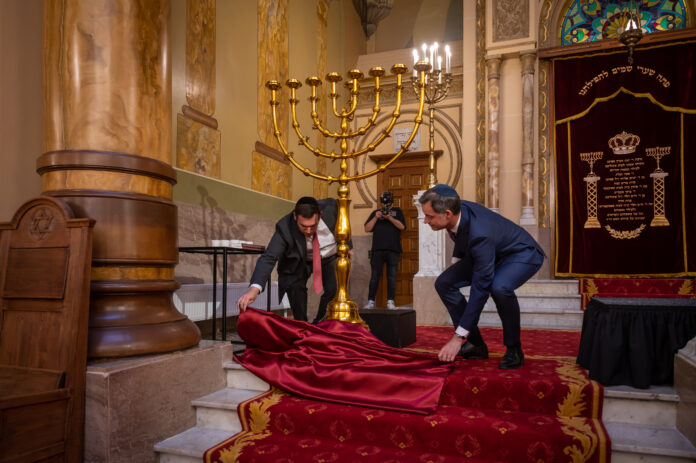Last Sunday, on May 7, the main shul of the Antwerp Orthodox Jewish community, Machsike Hadass, was inaugurated in the presence of Belgium Prime Minister Alexander De Croo as well as Bart De Wever, the mayor of Antwerp. Built over a century ago in the Art Nouveau style, it has recently undergone extensive renovations with the assistance of the Belgian government.
“The synagogue has been in existence for more than 100 years, and thanks to this fantastic renovation, it is ready for the next 100 years,” Prime Minister De Croo said at the ceremony. “The sober and timeless style of this building perfectly reflects the ancient Jewish traditions and customs.”
He also referred to the “dark clouds” that gathered over Antwerp in 1941. “Flemish anti-Semitic groups, encouraged by Nazi propaganda, carried out a horrific pogrom on the holy site where we stand today,” he recounted. “During this violent attack on the ‘Osten Shul,’ Jewish prayerbooks were burned and the entire contents of the synagogue were destroyed.”
The pogrom, known as the “Antwerp Kristallnacht,” was the start of anti-Jewish violence in the city and marked the beginning of the deportations of its Jewish community to concentration and extermination camps by the Nazis.
“This is not only the darkest page in Jewish history, but also in Belgian history,” said De Croo, who sees a connection between the two. The Jewish community “reminds us that Belgium’s strength lies in its diversity, a country where difference is not a problem but a wealth. As prime minister, I am therefore particularly proud that Belgium will continue to be a warm home for our Jewish community, which is a cornerstone of our society, both religiously and culturally.”
The closing speaker at the event, which was attended by hundreds of people, was the longtime chairman of the Jewish community, Pinchas Kornfeld. I had the opportunity to speak to Mr. Kornfeld late last week.
How long have you been living in Antwerp?
I was born here. When President Kennedy went to Berlin, he declared, “Ich bin ein Berliner.” I say, “Ich bin ein Antwerper.” Aside from the five years we had to flee during WWII, I’ve always lived here.
Are you the first generation born in Antwerp or were your parents born there as well?
My father was from the Russian part of Poland and my mother was from Galicia, the Austrian part of Poland. They both came to Antwerp separately. Then someone proposed the shidduch, so they got married and settled here. My father came to Antwerp because his brother, who was in the diamond trade, was already living here. That brother, Reb Shammai Shraga Kornfeld, was Rav Aharon Leib Shteinman’s shver. My mother came here because her mother was an almanah who had to raise six daughters, and there wasn’t enough to eat at home.
Historically, diamonds were what attracted Yidden to Antwerp. When did the Jewish involvement in the diamond trade begin?
It started centuries ago, but in more modern times most of the merchants worked in the harbor, on the west side of Antwerp. These were Jews who had come from Holland, France, Germany and England. They even built a large shul near the port, which was inaugurated in 1848 when Sir Moses Montefiore came to Antwerp from Ramsgate by carriage.
The building still exists, and it even has a mikvah, but it doesn’t function as a shul anymore; it’s owned by a furniture company. The mikvah can’t be accessed as the owner doesn’t want to open it because it’s so moldy and falling apart.
It wasn’t until the end of the 19th century that Jews began to arrive from Eastern Europe, especially from Russia, Galicia and Bessarabia (Romania). This was a good thing for the diamond industry because a lot of them were craftsmen. Most of them settled in the eastern part of town and opened a few small shuls there. They also bought land on Oosten (East) Street to build a larger shul.
Antwerp has been an ir v’eim b’Yisrael for a long time, especially after the war, when it was a destination for many refugees.
Yes. Many Jews who had managed to escape returned to rebuild it. Our own family fled to France and lived in hiding until later escaping to neutral Switzerland. Then we came back to Antwerp. A lot of survivors who had lived in other places in Europe before the war also wanted to be part of the kehillah. Reb Shlomo Klagbad, the rosh hakahal in those years, came straight from the camps in his inmate’s clothes. He was a real personality. People came back from Siberia, from hiding in Belgium, from the camps, from everywhere.
It’s interesting that there are almost no rebbes living in Europe anymore, but Antwerp had Reb Itzikel, and the Pshevorsker Rebbe Rav Leibish lives there.
True. The Pshevorsker Rebbes are very powerful personalities. Reb Itzikel, his son-in-law Rav Yankele, and now Rav Leibish, yibadeil l’chaim tovim, are world renowned. In fact, about a decade ago, a book called Ir V’eim B’Yisrael about Antwerp (in which I played a substantial role) was published in honor of the recent hachtarah of our new rav. At the time, I was the yosheiv rosh of the kehillah. I’m currently working on my memoirs, which I think I’m going to have to divide into at least two volumes, because you can’t publish a book with so many pages.
You’re probably familiar with Zichron Yaakov by Rabbi Yaakov Lifshitz, who wrote a memoir of his years with Rav Yitzchak Elchanan Spektor. That was also split into multiple volumes.
I have a lot to write about because the people I came in contact with over the years weren’t only from the frum community. I worked with Jews who weren’t frum, as well as with politicians and governments. I was the chairman of the European Board of Shechita, and I was also the vice president of the Consistoire Central Israélite de Belgique, the central council of all the officially recognized kehillos in the country. Now that I’m over 80, bli ayin hara, I’m allowed to take a bit of a break, but I haven’t stopped my activities. This week we had the chanukas habayis for our restored shul. I was involved in all the preparations, including writing the nusach of the sign at the entrance. I can’t stop working. Rav Meir Shapiro used to say, “I’m not in the Agudah; the Agudah is in me.”
Aside from being a gadol baTorah, Rav Meir Shapiro was also oseik b’tzorchei tzibbur be’emunah.
Of course. I once said a vort about the expression “be’emunah” in the brachah for those who are oseik b’tzorchei tzibbur. What about someone who isn’t oseik be’emunah? The answer is that one who isn’t working for the klal be’emunah nemt far zich alein (lines his own pockets). I was always oseik b’tzorchei tzibbur shelo al m’nas l’kabeil pras (without expectation of reward).
What made you decide to write your memoirs?
Around 30 years ago, I started publishing a weekly newsletter called Shabbos B’Shabbato. One of the columns was called “The History of the Jews of Antwerp.” The column ran for many years. At some point, I gave over the managerial operations to younger people, because I believe it’s important to give them a chance. As it is, they already think they can do things better than the older generation. I say, “Let them do it!”
After that, I started another newsletter called L’maan Teida, in Yiddish, which I kept up for 19 years. It was a weekly that consisted of approximately two dozen pages. There were 1,078 issues in total, or around 30,000 pages altogether. People ask me all the time when I’m going to start it up again. With Hashem’s help, I hope to do that after I finish my book. We had subscribers all over the world: Russia, Australia, Thailand, Finland, Portugal. A lot of people enjoyed reading the news from Antwerp or appreciated reading something in real heimishe mamme lashon.
I also wrote a sefer called Rechovos Ha’ir about the city’s eiruv. I was in charge of it for many years after the war. There was an eiruv before the war, but there was a problem with it so it had to be rebuilt. The sefer received the haskamos of Rav Kreiswirth, Rav Yitzchok Tuvia Weiss, Rav Eliyahu Sternbuch and Reb Yankele of Pshevorsk. I’d really like to print a second edition that would include almost a “heter mei’ah rabbanim”—so far, almost 25 rabbanim have given their haskamah—but I don’t have enough time. I’ve also written on other topics and in different languages.
In what language are you writing your memoirs?
In Yiddish. When someone writes a book, he has to write it in his native tongue. I’ll probably also translate it into English, Hebrew and, of course, Flemish and French.
These days, English and Hebrew are the two main languages spoken by Yidden.
I already have someone working on the translations. I need it to be very professional so I can show it to publishers and get some interest.
I think your memoirs would be very interesting in any language.
The first thing I have to do is decide what to include in the book. You have no idea how much I’ve accomplished over the last couple of months. I’ve written the outlines of innumerable chapters and have almost an unlimited number of stories to tell.
I’m going to have to make difficult choices. Just yesterday, I was speaking to someone from Eretz Yisrael who told me he was impressed by how much I was able to remember. “You must have a good memory,” he said. “Yes,” I quipped. “I even remember things that never happened!” (Laughs.)
By the way, when I first decided to write my memoirs, a non-frum Yid came to me and said, “These books are going to cost you a lot of money. I’ll cover all the expenses, but only on condition that you include all of the plotkes (unsavory stories) as well.” There were plenty of them in Antwerp over the years. But I told him, “I’m sorry, but I can’t do that.” So he made a second proposal: “Write two books. One will be with the plotkes, and the other will be without. I’ll pay for both.” (Laughs.)
By the way, my family reads Ami every week. I can’t talk to them when they’re reading it because they’re too engrossed.
That must be very good for shalom bayis.
Yes. That’s when I have extra time to learn. After all, there are things to learn besides Daf Yomi and Chumash with Rashi. Incidentally, I’ve been learning Daf Yomi for over 49 years with the same chavrusa. To which chasidus do you belong?
To read more, subscribe to Ami





















